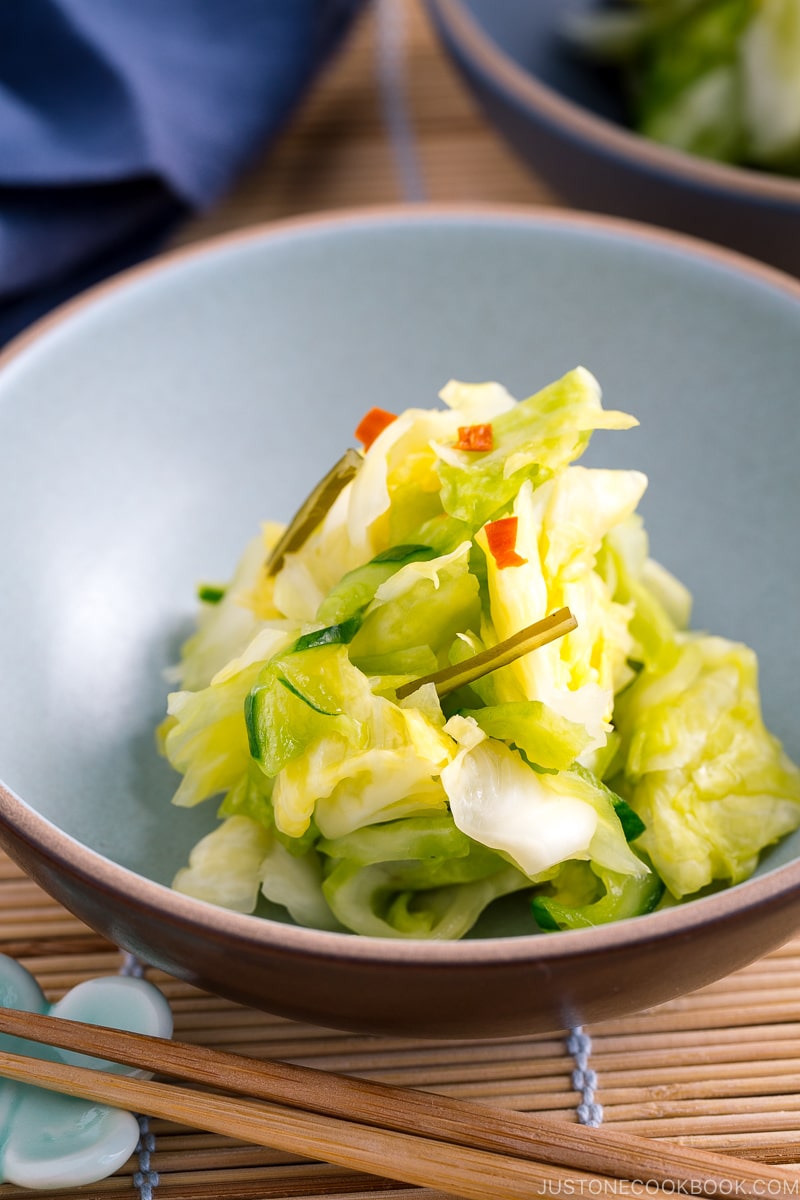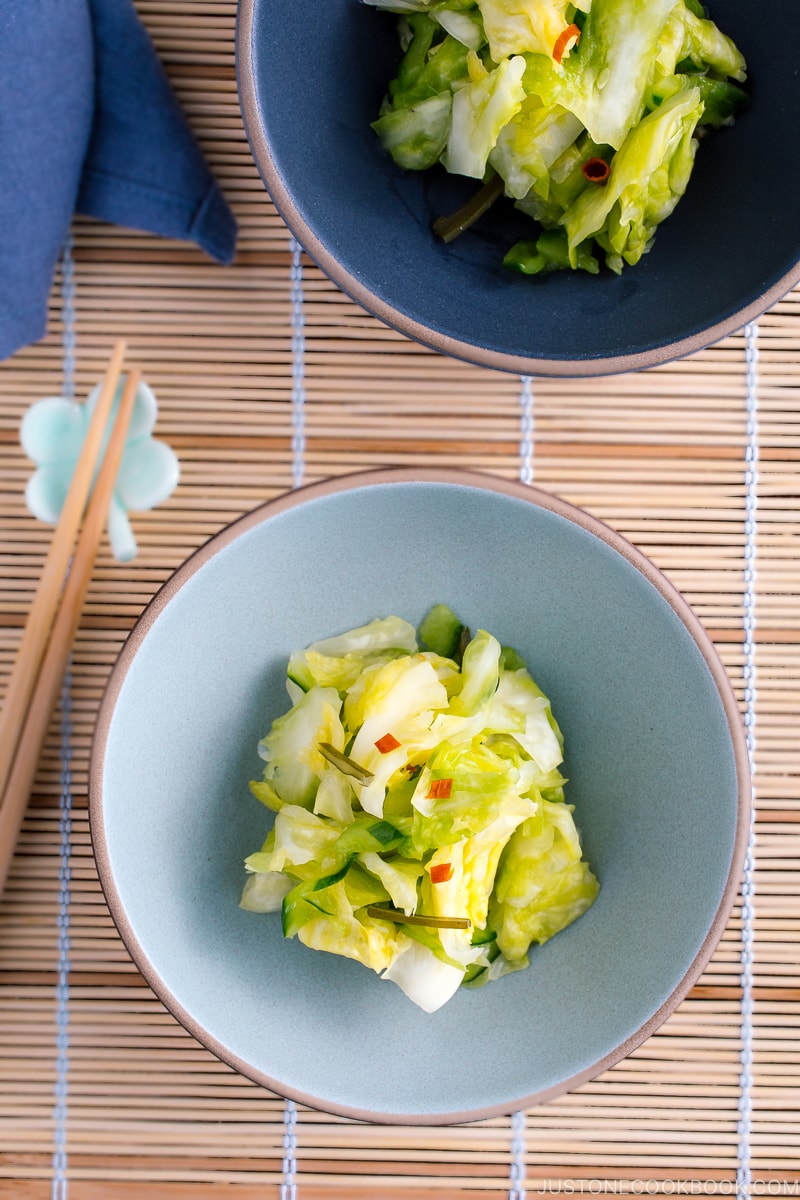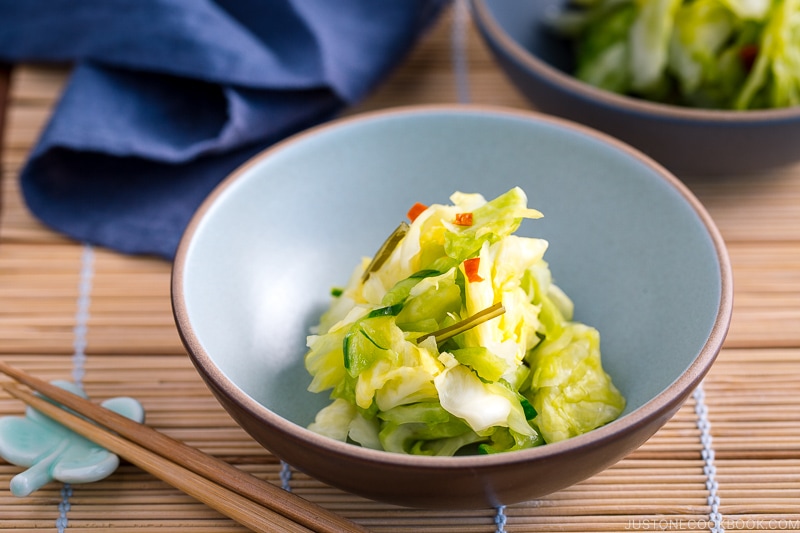Brined in salt, kombu, and chili flakes, crunchy Japanese Pickled Cabbage makes a refreshing palate cleanser to accompany any Japanese meal. This tasty and quick pickle (tsukemono) recipe is so easy to make at home. Ready in about 2 hours!

When we eat Washoku (和食), a traditional Japanese meal with rice and miso soup, we almost always serve a small dish of Japanese pickles called Tsukemono (漬物). Today I’m sharing a quick and easy Japanese Pickled Cabbage (キャベツの浅漬け).
What’s Tsukemono?
Tsukemono (漬物, literally translates to “pickled things”) are Japanese preserved vegetables that are usually pickled in salt, brine, or a bed of rice bran called nuka.
During a meal, Tsukemono cleanses the palate and provides refreshments to counter the other flavorful dishes. It also offers color, texture, and fragrance to a meal. In fact, it is sometimes also called Kounomono (Kho no mono, 香の物) or “fragrant things”.

“Asazuke” – A Quick Tsukemono
In Japan, all types of tsukemono are available at grocery stores and specialty stores; however many people make Asazuke (浅漬け) at home, which is “quick pickling”. I serve this type of tsukemono with steamed rice and miso soup for my traditional Japanese meals.
Among the different types of Asazuke, shio-zuke (塩漬け), or salt pickles, is one of the easiest pickles to make. With shio-zuke, vegetables are salted first, then the heavy object is placed upon the vegetables. The pressure causes the vegetables to release liquids, and the vegetables are pickled in the brine. Making shio-zuke usually requires just a few hours; therefore it’s a popular pickle for home cooks.
Keep in mind that Asazuke typically needs to be consumed within 2-3 days as it’s pickled in a very small amount of salt that’s not enough to keep it for a longer time without spoiling.

What can I make into Tsukemono?
There are quite a bit of ingredient options for making tsukemono. I personally like using vegetables like cabbage, napa cabbage, cucumbers, eggplants, daikon radish, turnips, gobo (burdock root), carrots, ginger, and more. What I recommend is to pickle 1 to 2 ingredients at a time. When I make my own vegetable tsukemono, I know it’s fresh and absolutely love the crispy texture!
How much salt to add?
My general rule of thumb for Asazuke is that salt should be 2 to 2.5% of the vegetable’s weight. It’s easy to calculate when you have a kitchen scale (I like this kitchen scale).
If you use Diamond Crystal kosher salt, 1 tablespoon is about 10 grams and 1 teaspoon is 3 grams.

Wish to learn more about Japanese cooking? Sign up for our free newsletter to receive cooking tips & recipe updates! And stay in touch with me on Facebook, Pinterest, YouTube, and Instagram.

Japanese Pickled Cabbage
Video
Ingredients
For the Vegetables
- ½ head green cabbage (9.9 oz, 280 g)
- ½ Japanese or Persian cucumber (1.8 oz, 50 g)
For Quick Pickling
- 1 dried red chili pepper
- 1 piece kombu (dried kelp) (1 x 3 inches, 2.5 x 7.6 cm per piece)
- 2 tsp Diamond Crystal kosher salt (use 2% of the vegetables’ weight; multiply the weight of the cabbage and cucumber by 0.02)
For the Toppings (optional)
Instructions
- Gather all the ingredients.

- Discard the core of ½ head green cabbage. Cut the cabbage into 1- to 2-inch (2.5- x 5-cm) pieces.

- Cut ½ Japanese or Persian cucumber in half and peel. Cut in half lengthwise then into thin slices diagonally.

- Remove and discard the seeds from 1 dried red chili pepper. (You can save the seeds to add in if you prefer a spicy taste.) Avoid touching the seeds with your bare hands/fingers. Cut the chili into rounds.

- Toast 1 piece kombu (dried kelp) over an open flame to make the kombu tender. Then, cut it into thin strips (I used kitchen shears).

To Brine
- Put the cabbage, cucumber, chili pepper, and kombu in an airtight plastic bag and add 2 tsp Diamond Crystal kosher salt.

- Rub together the ingredients from outside the bag until the cabbage softens. Remove the air and seal the plastic bag tightly.

- Place the bag under a heavy object. Place it in the refrigerator or a cool spot and let it pickle for 2–3 hours.

- Once the cabbage is pickled, take it out from the brine and squeeze out the excess liquid with your hands.

To Serve
- Transfer to a bowl or plate. Sprinkle with toasted white sesame seeds and drizzle with a little bit of soy sauce.

To Store
- You can keep the leftovers in an airtight container and store in the refrigerator for up to 2–3 days.






















When I make tsukemono with kombu, the kombu makes everything really slimy. Am I using the wrong kind of kombu, or doing something wrong with it?
Hi Yams! Thank you for trying Nami’s recipe!
Do you remove the pickles from the bag and squeeze the excess liquid out after marinating for 2-3 hours and the cabbage has been pickled?
The liquid will continue to make Kombu slimy.
We hope this helps!
Is it possible to freeze it for longer store time?
Hi Takemi! Thank you very much for trying Nami’s recipe!
Sure, you can freeze it, but the texture will change, and it won’t be crispy. If you freeze it, we recommend dividing it into one serving and wrapping it tightly, and putting it into a ziplock bag.
We hope this helps!
Thank you for the recipe! A quick question — is kombu edible in this recipe? or is it just for flavor and should be removed before eating?
Hi Dasha! Thank you very much for trying Nami’s recipe!
You can enjoy the Kombu together, and you do not need to remove it.
We hope this helps!
My favorite place growing up was a Japanese restaurant, owned by a sweet lady from Japan. Once seated, each person was served a very small dish of cabbage, which would be gone in seconds! The owner retired long ago and sold the restaurant. I’m so sad I will never get to eat this again. I love this recipe and it reminds me of it, but something I wonder – the cabbage this place served was dry? To me it just looked like dry cabbage and chili flakes, but had a beautiful flavor. Is this a dish you know?
Hi Penny! Thank you very much for reading Nami’s post!
Without looking at the actual pickled, it’s difficult to say. But we think it’s the same kind of Pickled. The difference is Cabbage is a smaller cut than this recipe. And after it is pickled, squeeze out the excess liquid very well and set it aside for a while.
We hope this helps!
How do you serve this? Say there are four people at dinner, and the other dishes are family style. Does each person get a tiny dish of pickles, or is there one bowl of pickles for everyone?
Hi hmucha! Either way is ok, but usually, pickles are served in the smaller dish for each person.
It is totally up to your preference.
We hope this helps!
This looks so good! Do you think this would work with daikon instead?
Hi Tanuja, Sure, you can use Daikon. Please feel free to adjust the pickled time (step 8) if needed it.
I have gained some weight during this pandemic. Do have some recipes that would be filling but low in calories? Thank you!
Hi Aileen, We hear you!
How about Honey Sesame Shirataki Noodles? : https://www.justonecookbook.com/honey-sesame-shirataki-noodles/
You can cut down the amount of sauce for even lower calories too. We hope this helps!
Thanks for sharing this recipe. It is very easy and refreshing. I am lucky to be able to get the imported Japanese white cabbage that is sweet and crunchy. Adding kombu changes the whole taste of the dish and add savory/umami taste to the tsukemono.
Hi Lee, We are so glad to hear you enjoyed Homemade Japanese Pickled Cabbage! Thank you very much for trying this recipe and for your kind feedback.
I’m gonna try make tsukemono myself thanks for the recipe! I don’t have an open fire stove but rather an electronic stovetop. Any other ways you recommend can soften the kombu? Also how long can you keep kombu in the fridge if I store in an airtight container? Thanks.
Hi Ritsuko, Thank you for trying this recipe! To soften the Kombu, you may try placing the Kombu over the steam for 10~15 seconds.
The Dry Kombu can be stored for up to 2 years if you keep them in good condition. https://www.justonecookbook.com/kombu/ We hope this is helpful!
Thanks Naomi! I followed the recipe and it tastes so good! Now I’m hooked and want to make more tsukemono. JOC is just the best English Japanese cooking site on the internet. Not only are there many great recipes but also info on the ingredients and culture. Thank you 🙂
Hi Ritsuko! Aww… You have no idea how much your kind words meant to us! Thank you, and we are glad you enjoyed this Tsukemono. 🥰
Nami,
Thank you for your Midnight Diner posts. Will you be posting from Season 3? I hope to see the recipe for pickled napa cabbage, and others. I love the show and your posting for other Japanese Dramas.
Hi Palma,
Thank you very much for trying many recipes and for asking about Season 3.
Yes. Nami is planning to post for Season 3 as well. Please stay tuned!😊
my sons grandfather used to make pickled cabbage that he called coco/koko. It used cabbage and salt but was dak in color.Do you have a recipe or know what these pickles were?
Hi Mary!
Koko is a name for Hawaiian pickled cabbage and very similar to the Japanese one.
However, we currently don’t have the recipe on the site. If you search on the internet with the keyword “Hawaiian pickled Koko,” you may found one just like your son’s grandfather used to make. We hope this helps!😉
This recipe sounds incredible! I’ve been wanting to explore the different options when it comes to pickling. I can’t wait to try. Thank you for sharing!
Hi Ashley,
Thank you very much for your kind feedback! We hope you like this Japanese Pickled Cabbage!
Hi Nami!
Is it ok to add kombu that’s been used to make dashi?
Thanks!
Hi Rina! No, you have to use a new one. It’s not for texture, but we need to extract the umami flavor from new kombu, not used (and flavorless) kombu. 🙂